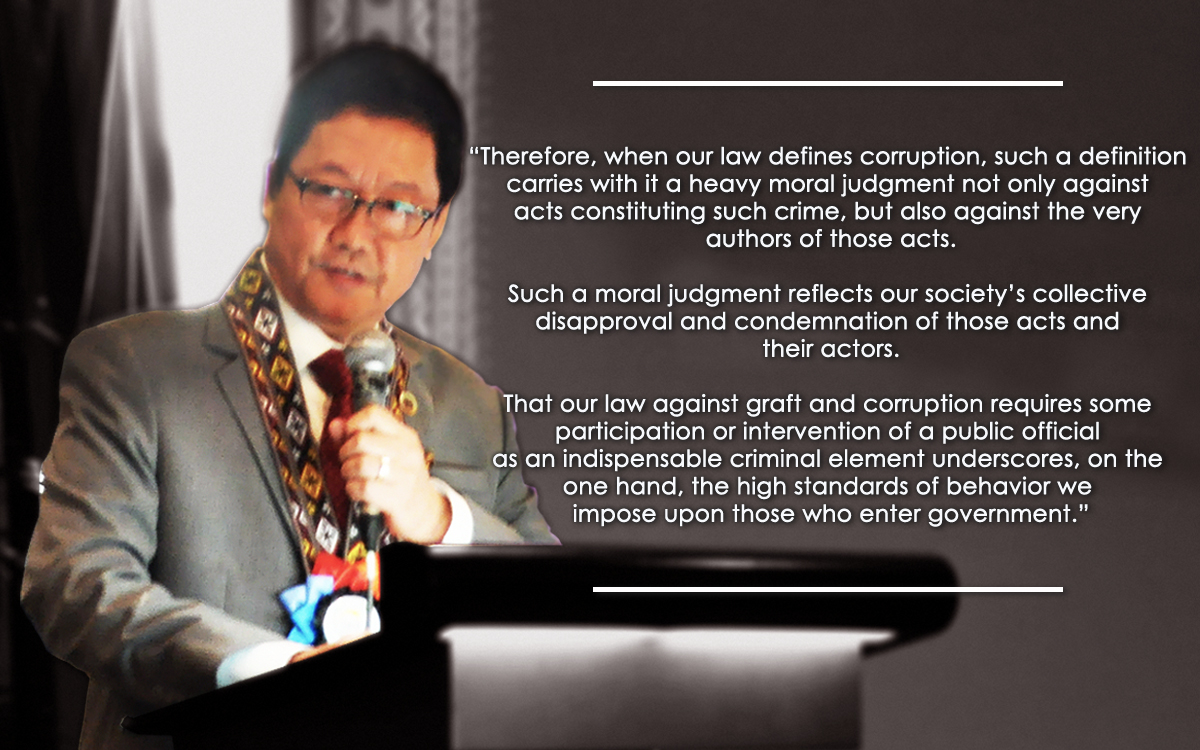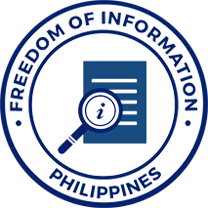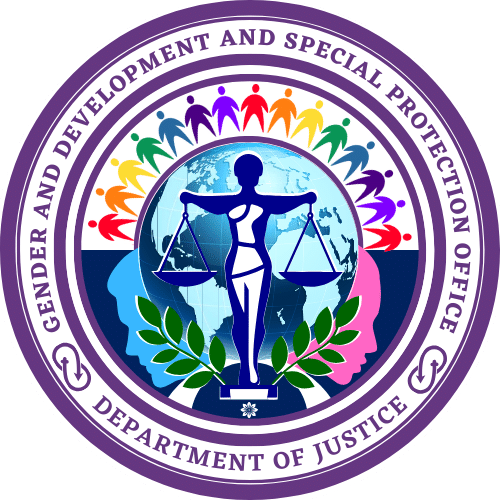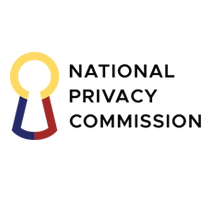Revitalizing the Fight Against Corruption In the Areas of Justice and the Rule of Law
09 December 2019, Diamond Hotel, Manila
Corruption is a social ill that is both pervasive in its influence and persistent through time.
Over a century ago, the great Malay thinker and our national hero devoted a good deal of his works on this subject.
He explored the corruption of the powers-that-be in this archipelago under the colonial set-up.
His Noli Me Tangere and El Filibusterismo would later on inspire a revolution against colonialism itself.
That revolution led to the creation of the First Republic in this part of the world.
That revolution was unquestionably a response against colonialism and its excesses.
But the rejection of the colonial project rested on, among others, our people's experience with corrupt leaders.
That the colonial regime aided these leaders' rise to power and created a system tolerant of their penchant for abuse became one of the rallying points of our revolution for independence.
This reminds us that as far back as a century ago, and even much earlier, there existed in this jurisdiction not only a recognition but a rejection of corruption and its evils.
A century hence, fighting corruption remains a challenge.
This challenge is so intractable that governments across jurisdictions - and even the international community as a whole - still lack confidence to assert the bold claim of having eradicated corruption altogether.
This state of things has generated some pessimism about the possibility of actually eliminating corruption.
It has even given rise to suggestions that moderation rather than total eradication is the more plausible approach.
While we are ready to explore this intersection of pessimism and realism in the hopes that we will, in the end, find our way out of the proverbial tunnel of corruption, we nevertheless reject the approach that proposes to moderate, instead of eliminate, this phenomenon.
For embedded in such an approach is the idea that certain levels of corruption may be necessary and must therefore be tolerated.
To this idea we cannot conform, in much the same way that our forebears refused to accept corruption, or levels thereof, as a necessary ingredient of their society and politics.
Instead, we choose without hesitation to continue the fight towards its total and complete eradication.
It is to this cause that I now devote my thoughts and energy in the hope that our exchanges today move as an inch forward towards winning this fight.
Understanding Corruption Using the Lens of the Law
The law is a powerful force that orders society and shapes how history unfolds.
It derives its power from the collective recognition ofthe norms and standards it sets, and the commitment of everyone to abide by and uphold those norms and standards, or to otherwise suffer penalties in case of one's failure to do so.
The law not only influences but directs human conduct through both moral suasion and threats of punishment.
When the law defines crimes, it at once makes known what is forbidden and deters disobedience with the imposition of penalties.
Therefore, when our law defines corruption, such a definition carries with it a heavy moral judgment not only against acts constituting such crime, but also against the very authors of those acts.
Such a moral judgment reflects our society's collective disapproval and condemnation of those acts and their actors.
That our law against graft and corruption requires some participation or intervention of a public official as an indispensable criminal element underscores, on the one hand, the high standards of behavior we impose upon those who enter government.
And yet, our inability at present to consider and define corruption as a crime that may arise in transactions between and among purely private parties, and to punish those who engage in them, has serious implications on our effort to prevent and eliminate this unwanted social ill.
At the very least, such inability propagates the obviously wrong notion that corruption does not happen in the private sector.
And while certain wrongdoings in the private sector which approximate corrupt acts in the public realm are now routinely prosecuted under certain laws - for example the law on frauds, estafa, or competition, to cite a few - these prosecutions tend to mask the real offense committed.
In addition, they somehow attenuate the gravity of our collective moral condemnation towards the act committed.
Our failure to categorize such acts as acts of corruption tends to further the lopsided view that corruption is not corruption when committed by private individuals only.
It creates a false dichotomy upon which the moral standards for the same acts differ, the difference determined merely by the realm where the acts occur and the nature of office of those who commit them.
Such false dichotomy is obviously an impediment to efforts at eradicating corruption wherever it may be found.
Accounting for the depth and cost of corruption
Such false dichotomy likewise makes the effort to account for how pervasive corruption is, and its real cost, difficult.
Because of our existing legal framework, our monitoring and measurement of corruption and its effects are largely focused on what happens in the public sector.
Admittedly, public officers and employees make decisions in the course of their work that significantly impact society.
This remains a valid and compelling argument for punishing corrupt acts in the public realm.
But the undeniable importance of private corporations and entities in our economy, and in the lives and fortunes of our countrymen, provides equally compelling reasons for us to account for, and to prevent and punish, corruption in the private sector.
Corrupt transactions do not only affect corporate bottomlines or shareholders' dividends.
They also have implications on the amount of taxes remitted to the government, and the available resources to improve the quality of services offered by private companies to the public, and those set aside for the welfare and well-being of their employees, to name a few.
Unfortunately, these costs have remained unaccounted for because of our limiting legal definition of what constitutes, or of who can engage in, corruption.
Worse, our accounting system for corruption that remains fixated on money lost leads to a woeful false sense of tolerance towards the phenomenon.
This incomplete accounting for estimated losses caused by corruption creates a wedge that distances the phenomenon from its real life effects.
It therefore takes away the urgency for actions that should have been done to address it.
Unless the effects of corruption - both in public and private spheres - are expressed in concrete terms that the public can readily grasp - for example, in social housing units left unbuilt; jobs which our industries have failed to create; salary increases not implemented; or life-saving medications left unpurchased - the social cost of corruption will remain nebulous.
Unless all the costs of corruption are fully accounted for, the fight against it will be punctured with complacency.
Until then, many of us will remain incapable of correctly assessing the gravity of this crime, the deprivation it generates, and the costs it entails.
Until then, we will not have a deep sense of appreciation for the urgent need to fight corruption and its evils.
Revisiting the Law and its implications
It is therefore imperative to revisit our laws on corruption and engage in a dialogue towards redefining this crime to account for the complex circumstances under which it happens.
Towards such end, our institutions tasked to deliver justice and uphold the rule of law must commence the arduous but necessary task of tracking and monitoring violations that approximate corruption, especially in the private sector.
This undertaking should not only give us a glimpse of the penumbra of corruption in the private sphere.
It should likewise assist us in the difficult task of crafting a holistic legislation that defines, prevents and effectively combats corruption, whenever and wherever it occurs.
This important undertaking of redefining our laws will understandably require a number of important changes in the way we structure our institutions and build capacities to fight corruption.
Currently, the jurisdiction of the Office of the Ombudsman and the Department of Justice (DOJ) in cases involving our existing law against graft and corrupt practices overlap.
Such an overlap exists both in criminal and administrative proceedings.
Once legislative efforts at defining corruption in the private sector bear fruit, investigations and prosecution of graft and corrupt practices in the public sector may be reserved exclusively to the Office of the Ombudsman.
Meanwhile, the DOJ may be given exclusive investigative and prosecutorial duties in cases involving corruption in the private sector.
This should remove the confusion around the jurisdictional competencies of our respective offices.
More importantly, the specialization resulting from this set-up should improve our investigative and prosecutorial competencies.
These competencies are essential not only in securing the conviction ofthe guilty but also in making a real dent against the evil of corruption.
But while we await the realization ofthese proposals, those ofus tasked to investigate and prosecute criminals, must find ways to ensure that in the interim, our existing legal framework remains effective and satisfies our anti-corruption goals.
Allow me, then, to discuss some of our initiatives at the Department designed to strengthen our fight against corruption within the current legal framework.
A brief glimpse into our current anti-corruption initiatives
The German philosopher Friedrich Nietzsche said, "Whoever fights monsters should see to it that in the process he does not become a monster."
Institutions and agents tasked to investigate corruption offenses are the natural targets of the corrupt and, therefore, deserve protection if our anti-corruption efforts are to succeed.
Layers of institutional protection must be put in place to insulate those who fight corruption from the very people who wish to corrupt them.
Establishing systems and protocols that render it difficult to identify key players in the prosecutorial-decision making processes is an important part of this layer of protection.
Since my assumption into office, for instance, the review of appealed decisions of our prosecutors in the Department follows a two-stage raffle system.
Under this system, a case is assigned by raffle to a review prosecutor who evaluates appeals from decisions made by the original investigating or inquest prosecutors.
Once a review prosecutor has drafted a resolution, the same is returned to the pool and re-raffled to an Assistant Secretary or Under Secretary who finally determines whether to approve, reject or modify such resolution.
The assignment by raffle is made by an office placed directly under the Office of the Secretary.
Such raffle and assignment is intentionally not made public to ensure that disputants are unable to identify those handling their appeals, much less influence the appeals process.
It is, however, a fact that this protocol carries costs, among them efficiency losses.
For example, in the review of this two-stage raffle, it has been suggested that keeping the reviewing prosecutors unaware of the Assistant Secretary or Undersecretary who will ultimately evaluate their work render them unable to adjust to their evaluators' philosophical inclinations and style.
It has been likewise suggested that such a protocol has removed the incentive for the review prosecutors to take their work seriously and own it.
Both allegedly increase the incidence of rejection or modification of the output of the review prosecutors, thereby duplicating efforts and delaying the resolution of appeals.
These so-called efficiency losses appear nothing more than short-term hurdles.
Foremost, it bears stressing that a review prosecutor must remain unaffected by the doctrinal inclinations and predispositions of those who ultimately evaluate their work.
To hold otherwise will not only remove the avenue for legal debate which broadens our appreciation for the law and its nuances.
It will also erode the legal objectivity so essential in the just resolution of appeals.
In any event, there should be no contest that efficiency losses ought to be addressed - as they are now being addressed by the Department - by means of specific interventions.
These interventions include trainings and workshops designed to enhance skills and the competency of prosecutors involved in the evaluation and review of appeals.
But there should likewise be no contest that these short-term efficiency losses which are in fact the price we pay for our respective learning curves - can never be used to justify compromising our existing anti-corruption initiatives.
To allow short-term impediments to derail our long-term anti-corruption objectives seems an unjustifiably uneven bargain.
Another layer of institutional protection relates to mechanisms already in place to purge the corrupt from those who investigate and prosecute cases of corruption.
Peer-led investigations in administrative proceedings sometimes yield less than acceptable outcomes.
Admittedly, the proper selection of investigating peers could significantly reduce instances of conflict of interest but this may not always be sufficient.
Appropriate action should be undertaken to hold administratively and criminally accountable those who purposely or otherwise neglect their duties to force the unwarranted acquittal of their peers.
This should impart in clear language our uncompromising stance against corruption, and our refusal to sanction the anomalous situation where those meant to guard our institutions from the corrupting influence of some pervert their own oaths to become willing accomplices in propagating the very evil we ought to fight
Meanwhile, we must not fail to give commensurate protection to those who take their duty to heart, even at the cost of friendships or professional relations.
Only through these twin measures can we guard our guardians against retribution and other threats.
Only then can we protect their resolve to act impartially and rightly in accordance with our laws, and with the best interest of the public in mind.
Only then can we truly say that the perceived gaps in our current laws pose no detriment to our unfaltering efforts against corruption.
Governments across history, regardless of their nation's level of development, ideology, and the health of its body politic, have continuously sought to eradicate corruption.
This unceasing effort stems from the understanding that corruption has pernicious effects on the integrity of national institutions, adversely affects governmental capacity to address the needs of our people, and ultimately robs people and families of the quality of life they rightfully deserve.
This effort is therefore one that none of us should abandon.
On the contrary, our effort should protect the gains we have so far achieved in this fight by providing layers of institutional protection in favor ofthose who remain loyal to our cause.
In the long term, however, our effort must likewise include the redefinition and expansion of the coverage of our laws that we may penalize every form ofcorruption, wherever it happens and whoever commits it.
Corruption is an evil that victimizes people across generations.
Filling in the gaps in our laws will not only unmask this evil; it should also enlarge the dragnet against all those who perpetrate it
More importantly, it will convey in no uncertain terms our staunchest condemnation of every act and against every person that seeks to corrupt us, our future, and our legacy.
Thank you and good morning to us all.








